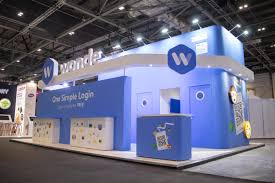In today’s competitive business environment, an exhibition stand is more than just a display booth—it’s an opportunity to make a lasting impression. Whether you’re attending a trade show, convention, or exhibition, your stand design plays a crucial role in attracting visitors, building brand awareness, and driving business success. A well-designed exhibition stand not only showcases your products or services but also represents your brand’s identity and values.
In this guide, we’ll explore the key elements of exhibition stand design, including its importance, tips for success, and how to create an engaging and memorable experience for attendees.
1. Why is Exhibition Stand Design Important?
The primary goal of an exhibition stand is to attract visitors and engage them effectively. The design of the stand plays a major role in achieving this goal. Here are some reasons why exhibition stand design is essential:
Attracting Attention
At any exhibition, hundreds or even thousands of exhibitors are competing for attention. An eye-catching and unique stand design can help your booth stand out in the crowd. Bright colors, creative structures, and interactive elements draw in potential customers and invite them to explore your offerings.
Building Brand Identity
Your exhibition stand is a direct reflection of your brand. The design should align with your company’s logo, color scheme, messaging, and values. A cohesive and professional stand design reinforces your brand identity and helps visitors instantly recognize your company. Consistency in design creates trust and credibility, which are essential for converting leads into business.
Creating Engagement
The right exhibition stand design encourages visitors to engage with your products or services. Incorporating interactive elements such as demonstrations, digital screens, or touchpoints can draw people in, making them more likely to spend time at your booth. An engaging stand helps to foster connections and build relationships with your audience.
Maximizing Space
Exhibitions are often busy, crowded spaces, and how you utilize your stand’s space is key to creating an efficient and pleasant environment for both your team and visitors. A thoughtful design maximizes the available space, ensuring smooth traffic flow, easy access to key products or materials, and a comfortable area for meetings or presentations.
2. Key Elements of Exhibition Stand Design
An effective exhibition stand design incorporates several essential elements to ensure success. These elements work together to create a balanced and visually appealing display that enhances your company’s message.
1. Layout and Flow
The layout of your exhibition stand should be planned with careful consideration of how visitors will move around and interact with your display. The design should make it easy for people to walk in and out of the stand, ensuring there’s enough space to prevent overcrowding. Open layouts often work well, but you can also create designated areas for specific activities, like product demos or private meetings.
2. Branding and Graphics
Branding is at the core of exhibition stand design. Your company’s name, logo, tagline, and colors should be prominently featured and easy to read from a distance. Large graphics, backdrops, and signage help communicate your brand’s message and attract attention. Use clear, concise language and imagery that resonates with your target audience. High-quality visuals and consistent branding elevate the professional look of your stand.
3. Lighting
Lighting is one of the most powerful tools for drawing attention and creating a mood in your exhibition stand. Well-lit displays highlight key products and features, while strategic lighting design can create ambiance. Consider using spotlights for product showcases or mood lighting to make the space feel inviting. LED lights are a popular choice due to their energy efficiency and ability to provide bright, even lighting.
4. Interactive Elements
Engaging visitors with interactive elements is an effective way to create memorable experiences. Touch screens, VR (Virtual Reality) setups, augmented reality (AR) displays, product demos, and live presentations can enhance the visitor experience and encourage them to spend more time at your stand. Interaction not only entertains but also educates visitors about your products or services in a hands-on way.
5. Product Displays
Your exhibition stand is an opportunity to showcase your products in the best possible light. Product displays should be organized, well-lit, and easy to access. Clear product labeling and informative materials are essential to help visitors understand what you’re offering. If your products are large or require demonstration, ensure there’s enough space for hands-on trials or presentations.
6. Technology and Digital Integration
Incorporating technology into your exhibition stand can give your booth a modern and innovative feel. Interactive touchscreens, video displays, social media integration, or QR codes linking to your website or promotional content can enhance engagement. Digital integration helps you stay connected with tech-savvy visitors and provides a dynamic experience.
3. Tips for Designing an Effective Exhibition Stand
Now that we’ve covered the essential elements of exhibition stand design, let’s look at some practical tips to ensure your stand leaves a lasting impact.
1. Define Your Goals
Before you start designing your exhibition stand, define your objectives. Are you looking to increase brand awareness, generate leads, launch a new product, or build relationships with potential clients? Knowing your goals will guide the design process, ensuring that every element of the stand supports your overall objectives.
2. Keep It Simple and Focused
While it’s tempting to cram as much information or as many products as possible into your stand, simplicity is key. A cluttered stand can overwhelm visitors and reduce the effectiveness of your messaging. Focus on your core message, and prioritize the key elements that will attract your target audience.
3. Incorporate Your Brand’s Personality
Your stand should feel like an extension of your company’s personality. Whether your brand is professional, creative, playful, or luxurious, make sure that the design reflects these traits. Whether it’s the use of colors, materials, or shapes, the design should speak to your target audience and help them connect with your brand.
4. Prioritize Visitor Experience
Visitor experience should be at the heart of your design. Create a welcoming environment by ensuring there is sufficient space for visitors to move around freely. Consider seating areas for discussions, quiet zones for private meetings, and areas for product interaction. Make sure your staff are approachable, knowledgeable, and ready to engage with visitors.
5. Plan for Logistics
Think about the practical aspects of the stand design. How easy will it be to transport and set up? Do you have enough storage for marketing materials, brochures, and products? Make sure your stand is easy to assemble and disassemble, and that you have a clear plan for transportation and storage.
4. Conclusion
Exhibition stand design is a crucial element of any successful trade show or exhibition. It’s your opportunity to attract attention, engage visitors, and showcase your brand’s products and services in a memorable way. By focusing on the key elements of layout, branding, lighting, interactivity, and technology, you can create a stand that effectively communicates your brand’s message and leaves a lasting impression. With thoughtful planning and creative design, your exhibition stand can become a powerful tool for generating leads, strengthening relationships, and ultimately driving business growth.



